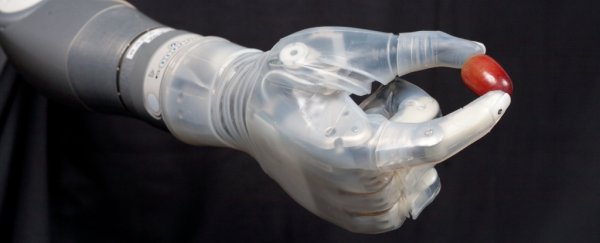Research on robotic prostheses is coming along in leaps and bounds, but one hurdle is proving quite tricky to overcome: a sense of touch. Among other things, this sense helps us control our grip strength - which is vitally important when it comes to having fine motor control for handling delicate objects.
Enter a new upgrade for the LUKE Arm - named for Luke Skywalker, the Star Wars hero with a robotic hand. Prototype versions of this robotic prosthesis can be linked up to the wearer's nerves.
And, thanks to biomedical engineers at the University of Utah, for the participants of their experimental study, the arm can now also produce an ability to feel. This spectacular advance allowed one wearer to handle grapes, peel a banana, and even feel his wife's hand in his.
Keven Walgamott lost his left hand and part of his arm in an electrical accident 17 years ago. When the research team asked for an amputee to test the robotic prosthesis prototype they had been developing, he willingly volunteered.
"It almost put me to tears," he said, referring to using the arm for the first time. "It was really amazing. I never thought I would be able to feel in that hand again."
The arm has been in development for 15 years, and it taps into the way our brains control our limbs by sending signals through the nervous system.
This technology is called peripheral nerve stimulation, and engineers have been exploring its use in upper limb prostheses for years.
Electrodes are attached to the nerves in the arm above the amputation site, and also to the prosthetic. The user then thinks about moving the hand and arm. It takes a bit of training - everyone's neural activity is different - but gradually, the software that runs the arm learns the user's neural signals for controlling the prosthesis, and basic dexterity is restored.
The LUKE Arm, developed by Mobius Bionics, has 100 microelectrodes that are connected to the nerves in the upper arm, and also to an external computer.
But sense of touch is relayed from the limb to the brain, so to generate a robotic ability to 'feel', the research team needed new tricks. The robotic hand has sensors that can mimic the feeling of touch.
The challenge to relay that information back to the brain in the correct way is the next, more difficult step.
"Just providing sensation is a big deal," said biomedical engineer Gregory Clark of the University of Utah.
"But the way you send that information is also critically important, and if you make it more biologically realistic, the brain will understand it better and the performance of this sensation will also be better."
A 'feeling' prosthetic developed by DARPA and unveiled in 2015 solved this with electrodes connected directly to the sensory cortex of the brain, but Clark's team wanted a less invasive solution.
When you touch something, a burst of signals is immediately sent up the nerves to the brain, after which it tapers off. The team recorded this activity from the arm of a primate, and performed mathematical calculations to work out an approximation of how this happens in humans.
A model based on these calculations was then integrated into the software for the LUKE Arm, and refined. And it worked.
It gave Walgamott enough of a sense of feeling that he could pull grapes from their stems without crushing them. He could handle an egg without cracking it. He could peel a banana without squashing it. He could send a text message on his phone.
"One of the first things he wanted to do was put on his wedding ring. That's hard to do with one hand," Clark said. "It was very moving."
The paper focuses primarily on touch, but there's also a capability to relay temperature and pain, something the researchers want to further develop in the future. The team also wants to develop a wireless version of the LUKE Arm that does not need to be connected to an external computer, so that it can be used in day-to-day life.
For now, it remains a research prototype in a lab. But the team hopes that by 2021, three study participants may even be able to take their LUKE Arm home.
The research has been published in Science Robotics.
